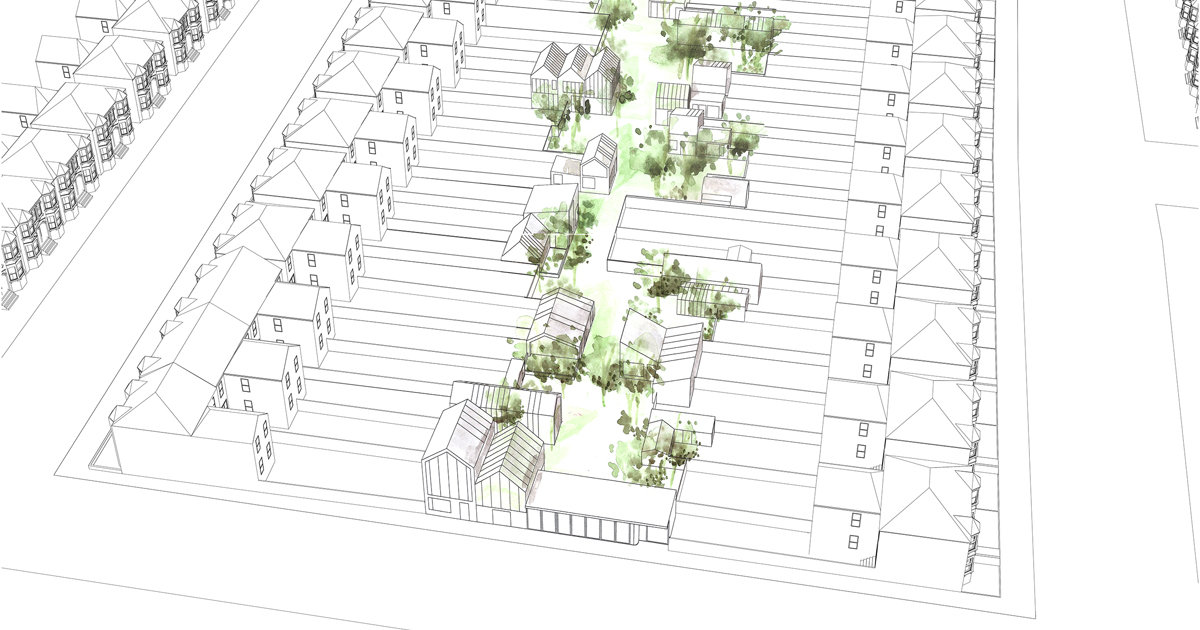
This project starts with Elly, an 83 years-old resident of South-east London.
I was inspired by the way she was enjoying her slow life and our conversation made me realise the importance of the details that brightened her life.
I wanted to propose a design that had the same intimate quality as her home, thanks to a careful choice of materials and tectonic details.
On the other end, this project is an alternative solution to the densification by destruction of New Cross Gate. A Victorian mutation: to increase density by bringing complexity to the urban tissue.
Some of the existing gardens go up to 35m deep and in this space lies great potential. Redistributed, it would enable the creation of new housing but also propose services that would spring from residents’ initiative, as well as a large garden or park that would belong to this community.
The unfolded home is not a specific master plan or house design but it’s a tool box. Rules, materials, details, structures and examples are in it but they leave some room for experimentations and above all choice. Raw materials and structures are standard (hence affordable) but each design is intended to be particular to each inhabitant.
This project embraces all scales, from the local urban realm to the door handle and celebrates distinctiveness.
The International Masters studio Urban Field Works challenged students to develop Radical Spatial Interventions for an Aging Society in an inner-city area in the Southeast of London. The entry point into the project was an afternoon of shared conversations with a group of Senior Citizens at the Albany, a local community centre in Deptford.
This is where Lily Benoit met Ellie, 92.
Ellie spoke of her daily routine, her outings, but also about the importance of her home, where she spends a considerable amount of time. Was this the home where the old lady was trapped, or a heaven of peacefulness? Perhaps both, but slowness and dedication to the details of her daily routine seemed to have awoken resilience and appreciation, inhabitation augmenting the essence of home, as Gaston Bachelar would put it. There was the chair from which she can observe the birds in the garden and the table around which she and her son gather for cake every Sunday, an unassuming London terrace as the holder of a distinct choreography. How could Lily emulate and embrace this quality? Could the sense of home perhaps partially reside in the preciousness of the making process itself, bestowing quality upon the object? But this was Lewisham, a deprived district in South London. A sense of economical affordability had to enter the equation that dealt with the problem of an inflated rental and property market and the fact that many Londoners were effectively priced out of the capital. Lily used, what can only be described as a desperate state of affairs to her advantage by devising an urban strategy that engaged with the forces of the property market. The local council or collectives would buy up Victorian terraces that came up for sale in a plot with overtly generous private gardens. They would reduce the size of the gardens to free up spaces in the core of the plot, making way for a communal park and other services, such as cafés, repair shops, informal day-care and guest accommodation. This would densify the area without erasing what was already there. Slowly, but steadily a new zone would emerge in the core of the plot that would transform the residential monoculture, nurturing a sense of community that would in turn enables isolated people, or impaired Senior Citizens to partake in urban life at the back of their gardens. Inspired by the more informal construction patterns that often reside at the back of the house, Lily devised a system that combined simple building techniques with distinctive crafted elements, merging economy with preciousness.
And so it was, that Lily’s work became precious to us.